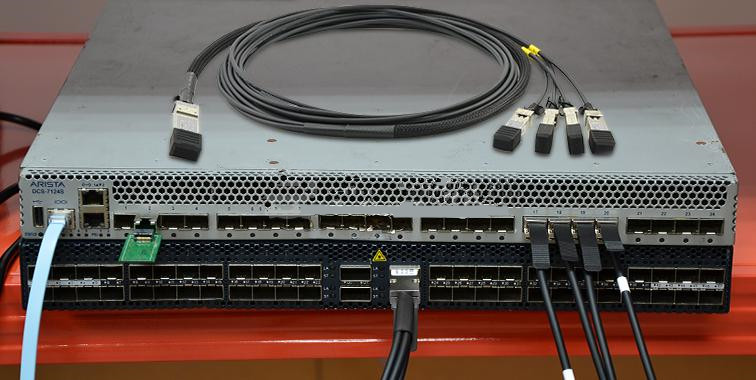Driven by need for high speed Ethernet and increasing services like Cloud and virtual data center, many data centers have been loaded with numerous cables and various equipment. Due to this case, shortage of data center space is common but it’s getting difficult and expensive to build new or expand existing locations. Today this post intends to introduce a type of cable – DAC cable (direct attach cable), which can solve this problem effectively.
Overview of Direct Attach Cable (DAC Cable)
Direct attach cable is a type of copper cable similar to coaxial cable, but it has SFP+, QSFP+ or QSFP28 plus at each end integrated. DAC cable is usually used in data centers for short transmission between racks. Generally, according to the construction differences, the DAC cable comes in two types: passive and active DAC. Passive cable is suitable for short distances up to 10 m and active DAC has a little longer transmission distance up to 15m at 10Gbps or 40Gbps, because it has an active component to boost/receive signal. And passive DAC cable requires no power for internal electronics, which avoid consuming power or produce heat. While active DAC comes in reverse, it needs power to make its internal circuits work properly.
On today’s markets, in order to satisfy the ever growing need for cost-effective delivery of more bandwidth, there are mainly three kinds of DAC according to the transmission rate: 10G SFP+ DAC, 40G QSFP+ DAC and 100G QSFP28 DAC.
10G SFP+ cable offers the high density, low cost and low power solutions for today’s 10G Gigabit Ethernet connections. With its SFP+ interface, this twinax cable allows interconnects with hot-pluggable optical transceivers and Ethernet switches in data centers. As shown in the picture below, two Cisco catalyst switches are connected with a 10G SFP+ DAC.

40G QSFP+ cable offers a way for 40G Gigabit short distance connections between QSFP ports switches. As its name shows, 40G QSFP+ DAC has QSFP+ connectors on both ends. And it uses integrated duplex serial data links for bidirectional communication. 40G QSFP+ DAC is a little different from 10G DAC cable. There are two types of 40G QSFP breakout DAC cables: 40G QSFP+ to 4XSFP+ DAC and 40G QSFP+ to 4xXFP DAC. These breakout DAC cables can be used to migrate from 10G to 40G.

The last one is 100G QSFP28 DAC. The 100G QSFP28 DAC cables are high speed cable to meet and exceed 100G Gigabit Ethernet, providing connectivity between devices using QSFP28 ports. The 100G QSFP28 DAC includes QSFP28 to QSFP28 and QSFP28 to 4xSFP28 breakout DAC. These interconnect cables provide four channels of high speed differential signals with data rates ranging from 25Gbps up to potentially 40Gbps.
Advantages and Disadvantages of Direct Attach Cable (DAC Cable)
Twinax DAC cables come into play in data centers mainly because of two factors which also show its superiority. We all know that denser equipment in the data center or server rooms will consume more electrical power and produce more heat. That means more cooling systems are required. However, DAC cables have the potential to reduce the overall power consumption and heat dissipation, which help network operators save cost. Another factor is that DAC cable is robust and does not need patch panels or additional cables when connected to devices, as is the case with an optical module. The modules on both ends make them sturdy and reliable as well as space-saving.

Nothing can be perfect, so do the DAC cables. Although they can save space and cost for data center managers, the drawbacks still exist. As the main element of DAC cable is copper, it is heavy and bulky, causing difficulties for management. What’s more, if DAC cables are deployed in high volume, the cable diameter and cable stiffness are another problem that should be considered. In this case, active optical cables (AOC cables) seem to be a better choice, for they are made of thinner and more pliable optical cable.
Summary
DAC cable provides a low power consumption and high-speed solution for data center interconnections. With the ability to support data rate of 10G, 40G and 100G, they are now widely used in optical links. All the DAC cables mentioned above are supplied in FS.COM. If you need to know more details, please visit www.fs.com or directly contact us via sales@fs.com.
Related Article: Use High Speed Direct Attach Cable for Data Center Interconnection




